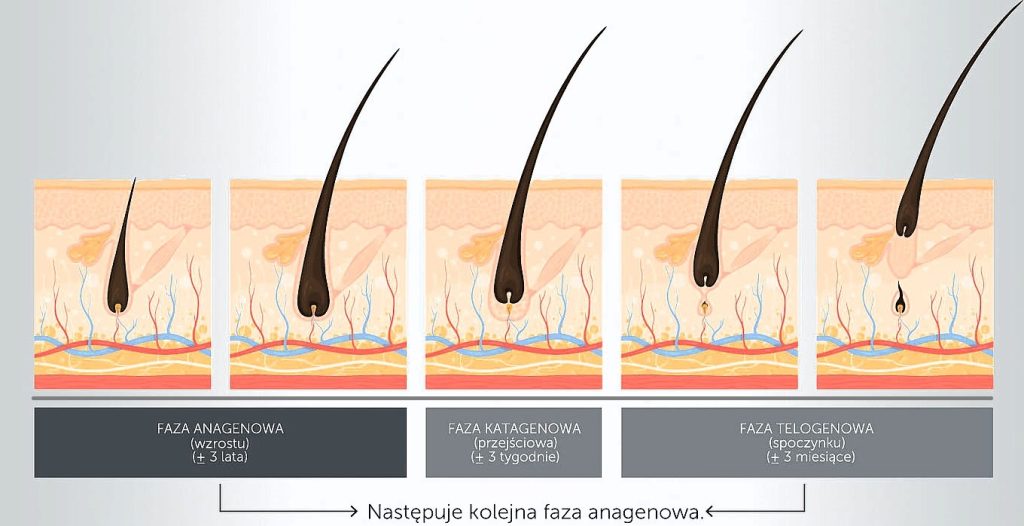Phases of hair regrowth after depilation. What does science say?
Blog BackTable of Contents:
- The hair growth cycle: 3 main phases
- 1. Anagen phase (growth phase)
- 2. Catagen phase (transition phase)
- 3. telogen phase (resting phase)
- How do the different hair removal methods affect the hair growth cycle?
- What does the science say about hair regrowth?

Depilation, regardless of the method, does not remove hair permanently (with the exception of laser depilation). Hair always grows back, and the rate of this process depends on the hair's life cycle, which runs in specific phases. Knowledge these phases can help to better understand why hair grows back after depilation and how different hair removal methods affect hair regeneration. Scientists have long studied the hair growth cycle in order to develop more effective and long-lasting depilation methods. Let's take a closer look at this biological process.
The hair growth cycle: 3 main phases
Body hair goes through three main growth phases: anagen, catagen and telogen. Each of these phases is characterised by different cell activity and follicle function.
1. Anagen phase (growth phase)
The anagen phase is the period when the hair is actively growing. In this phase, the hair follicle is fully functional, producing new hair. This is the longest phase of the cycle and its length depends on the location of the hair on the body - hair on the head can be in the anagen phase for up to several years, while hair on the legs or underarms has a shorter cycle, lasting from a few weeks to a few months.
During mechanical depilation (e.g. shaving, waxing or depilatories), hair is often removed when it is in the anagen phase. Removing the hair with the root in this phase may result in slower regrowth, but this will not stop the hair from growing again.
2. Catagen phase (transition phase)
The catagen phase is a short phase that usually lasts from a few days to a few weeks. It is a transitional period between the growth phase and the resting phase, when follicle activity decreases and the hair stops growing. The hair follicle begins to shrink, the cells responsible for hair growth die, and the hair separates from its root, preparing for the telogen phase.
Depilation in this phase is less effective because the hair is no longer as firmly rooted in the skin, but is still connected to the follicle. The hair in the catagen phase does not grow, so its removal can give the impression of a longer period of smoothness, as there is no new hair to replace it.
3. telogen phase (resting phase)
The telogen phase is the resting period when the hair is ready to fall out. During this phase, the hair follicle does not produce new hair and the hair that is still in the skin gradually falls out, leading to its replacement by a new hair in the next anagen cycle. Approximately 10-15% of all body hair is in the telogen phase at any given time.
Depilation during this phase often does not produce immediately visible results, as the hair that is about to fall out is already ready to fall out naturally. The regrowth of new hair, which is already in the growth phase, cannot be inhibited during this period either.
How do the different hair removal methods affect the hair growth cycle?
Different hair removal methods affect the hair growth cycle in different ways, which is important for understanding how effectively they eliminate hair and what the side effects may be. Methods that remove hair from the root (such as waxing, laser hair removal, or electrolysis) may lead to longer regrowth and longer-lasting results. Methods that only work on the skin’s surface (such as shaving, chemical hair removal) lead to faster hair regrowth. It’s important to choose the right method for your needs and expectations, as well as to understand how the procedure will affect the hair growth cycle. Below is a list of the most popular hair removal methods and their effects on the hair growth cycle.
- Shaving only removes the visible part of the hair above the skin, without affecting the root or follicle, so it doesn't change the hair growth cycle. The hair in each phase of the growth cycle grows back quickly, often within just one or two days, as the follicle remains active. Additionally, their structure may appear thicker because the ends of the hair are cut, making them rough.
- Wax depilation and mechanical depilatories remove the hair together with the follicle, which means that the hair needs more time to grow back. As these treatments remove hair in the anagen phase, the regrowth process can take several weeks, depending on the growth cycle of a particular hair. New hair starts to grow when other hair is already in the catagen or telogen phase. Regular waxing can lead to weakened hair and a thinner structure.
- Laser depilation works best on hair in the anagen phase, when hair follicles are most active. This method uses laser energy that is absorbed by the melanin in the hair, which leads to its destruction. After a series of treatments, many of the hairs in the anagen phase are permanently removed. The laser mainly works on hairs in the anagen phase, so the effects are most noticeable if the treatments are performed when the hair is in this phase. Hairs that are in the catagen or telogen phase may not be removed and may grow back later, which may require additional treatments, hence the need to repeat the hair removal with this method.
- Chemical hair removal - Depilatory creams contain chemicals that dissolve the proteins in the hair, allowing them to be easily removed. This method works on the skin's surface and does not remove the hair follicle, meaning the hair can still grow back. The hair will start to grow back after a few days, usually faster than after waxing.
- Electrolysis involves the introduction of an electric current into the hair follicle, which leads to its destruction. It is one of the few methods that can lead to permanent hair removal, as it works on the hair bulb. Each hair must be treated individually, which makes the procedure time-consuming but very effective.
- IPL (Intense Pulsed Light) Hair Removal - Similar to laser, IPL technology uses light to destroy hair follicles, but works on a wider range of wavelengths. IPL works effectively on hair in the anagen phase, and the effects are similar to those obtained with a laser. The method requires several sessions to achieve lasting results.
What does the science say about hair regrowth?
Scientists agree that the hair growth cycle is crucial to the effectiveness of different depilation methods. Hair growth and cycles are also regulated by genetic and hormonal factors. This is why some people may notice that their hair grows back faster or slower after epilation compared to others. Knowing what phase the hair is in allows us to better understand why some treatments are more permanent and others need to be repeated more often. The most effective depilation methods, such as laser depilation, target the anagen phase, when hair is most receptive to hair removal technology. The effect of different hair removal methods on the hair growth cycle has been the subject of much research, and the effects may vary from person to person.









